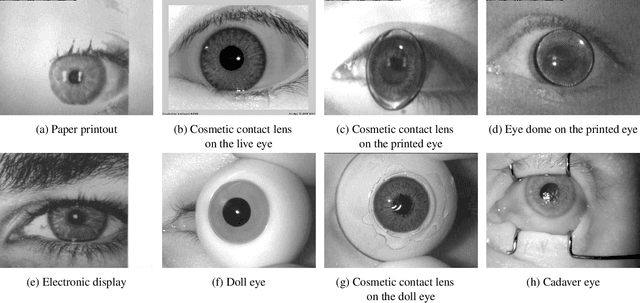Joseph McGrath
Iris Liveness Detection Competition (LivDet-Iris) -- The 2020 Edition
Sep 01, 2020



Abstract:Launched in 2013, LivDet-Iris is an international competition series open to academia and industry with the aim to assess and report advances in iris Presentation Attack Detection (PAD). This paper presents results from the fourth competition of the series: LivDet-Iris 2020. This year's competition introduced several novel elements: (a) incorporated new types of attacks (samples displayed on a screen, cadaver eyes and prosthetic eyes), (b) initiated LivDet-Iris as an on-going effort, with a testing protocol available now to everyone via the Biometrics Evaluation and Testing (BEAT)(https://www.idiap.ch/software/beat/) open-source platform to facilitate reproducibility and benchmarking of new algorithms continuously, and (c) performance comparison of the submitted entries with three baseline methods (offered by the University of Notre Dame and Michigan State University), and three open-source iris PAD methods available in the public domain. The best performing entry to the competition reported a weighted average APCER of 59.10\% and a BPCER of 0.46\% over all five attack types. This paper serves as the latest evaluation of iris PAD on a large spectrum of presentation attack instruments.
Open Source Presentation Attack Detection Baseline for Iris Recognition
Sep 26, 2018



Abstract:This paper proposes the first, known to us, open source presentation attack detection (PAD) solution to distinguish between authentic iris images (possibly wearing clear contact lenses) and irises with textured contact lenses. This software can serve as a baseline in various PAD evaluations, and also as an open-source platform with an up-to-date reference method for iris PAD. The software is written in C++ and uses only open source resources, such as OpenCV. The method does not require iris image segmentation and uses Binary Statistical Image Features (BSIF) to extract PAD-related features, which are classified by an ensemble of SVM classifiers. The SVM models attached to the current software have been trained with the NDCLD'15 database and the correct recognition rate exceeds 98%. However, the software implements the functionality of retraining the classifiers with any database of authentic and attack images.
 Add to Chrome
Add to Chrome Add to Firefox
Add to Firefox Add to Edge
Add to Edge